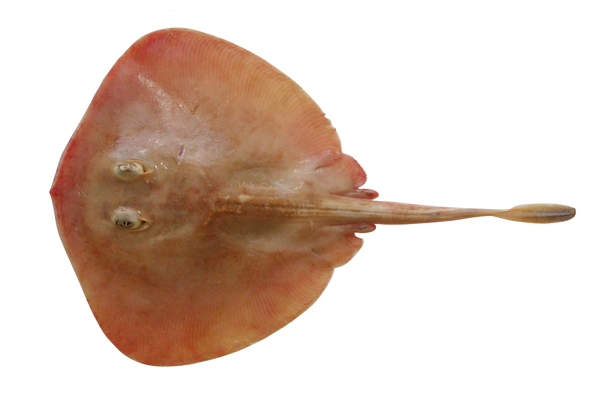Lobed Stingaree, Urolophus lobatus McKay 1966

Lobed Stingaree, Urolophus lobatus. Source: Australian National Fish Collection, CSIRO. License: CC by Attribution-NonCommercial
Summary:
A sandy-brown stingaree with slightly paler margins on the disc, and sometimes irregular blotches; dorsal fin absent. This small stingaree is found only in southwestern Australia.
Cite this page as:
Bray, D.J. 2018, Urolophus lobatus in Fishes of Australia, accessed 01 Jul 2025, https://fishesofaustralia.net.au/Home/species/3535
Lobed Stingaree, Urolophus lobatus McKay 1966
More Info
|
Distribution |
Endemic to south Western Australia, from Esperance to Penguin Island. Inhabits seagrass beds and sandy areas in depths to 35 m. |
|
Features |
Disc subcircular, much wider than long, anterior edge forming obtuse angle; snout fleshy, tip slightly extended in some; eyes of moderate size (22–35% preocular snout length); posterior margin of spiracles mostly rounded; 9–10 papillae on mouth floor; internasal flap with anterior angle extended into very distinct semi-circular lobe (as pronounced lobe-like bulges); nostrils short, posterolateral border forming narrow angular fleshy lobe; no dorsal fin; tail very depressed, rather elongate (87–100% disc length), lateral skin folds well developed; caudal fin long, narrow lanceolate, dorsal fin absent. |
|
Colour |
Dorsal surface sandy brown with slightly paler lateral margins; sometimes with irregular blotches; tail with narrow dark median stripe in some; ventral surface white, sometimes with darker blotches; caudal fin dark posteriorly. |
|
Feeding |
Carnivore - feeds mostly on crustaceans, especially mysids, carid decapods and amphipods. |
|
Biology |
Stingarees are aplacental viviparous, meaning that the embryos emerge from eggs within the uterus and undergo further development until they are born. After emerging from their egg cases, the embryos are initially sustained by their yolk, and later by histotroph, a "uterine milk" produced by the mother. Lobed Stingarees breed during summer and females produce 1-2 pups after a gestation period of 10 months. |
|
Fisheries |
The Lobed Stingaree is a common compnent of by-catch in the scallop and prawn trawl fisheries that operate off Perth and Mandurah, WA. |
|
Species Citation |
Urolophus lobatus McKay, 1966, J. Roy. Soc. W. A. 49(3): 71. Type locality: off Rottnest Island, WA. |
|
Author |
Bray, D.J. 2018 |
Lobed Stingaree, Urolophus lobatus McKay 1966
References
Gomon, M.F., Yearsley, G.K. & Last, P.R. 2008. Family Urolophidae. 125-137 pp. in Gomon. M.F., Bray, D.J. & Kuiter, R.H (eds). Fishes of Australia's Southern Coast. Sydney : Reed New Holland 928 pp.
Hyndes, G.A., Platell, M.E., Potter, I.C. & Lenanton, R.C.J. 1999. Does the composition of the demersal fish assemblages in temperate coastal waters change with depth and undergo consistent seasonal changes? Marine Biology 134: 335-352.
Last, P.R. & Stevens, J.D. 1994. Sharks and Rays of Australia. Canberra : CSIRO Australia 513 pp. 84 pls.
Last, P.R. & Stevens, J.D. 2009. Sharks and Rays of Australia. Collingwood : CSIRO Publishing Australia 2, 550 pp.
Last, P.R., Yearsley, G.K. & White, W.T. 2016. Family Urolophidae pp. 676-705. In: Last, P.R., White, W.T., de Carvalho, M.R., Séret, B., Stehmann, M.F.W. & & Naylor, G.J.P. (eds) Rays of the World. Melbourne: CSIRO Publishing, 800 pp.
McKay, R.J. 1966. Studies on Western Australian sharks and rays of the families Scyliorhinidae, Urolophidae and Torpedinidae. Journal of the Royal Society of Western Australia 49(3): 65-82 figs 1-6
Platell, M.E., Potter, I.C. & Clarke, K.R. 1998. Resource partitioning by four species of elasmobranchs (Batoidea: Urolophidae) in coastal waters of temperate Australia. Marine Biology 131(4): 719-734.
White, W.T. 2006. Urolophus lobatus. In: IUCN 2013. IUCN Red List of Threatened Species. Version 2013.2.
White, W.T., Platell, M.E. & Potter, I.C. 2001. Relationship between reproductive biology and age composition and growth in Urolophus lobatus (Batoidea: Urolophidae). Marine Biology 138: 135-147.

